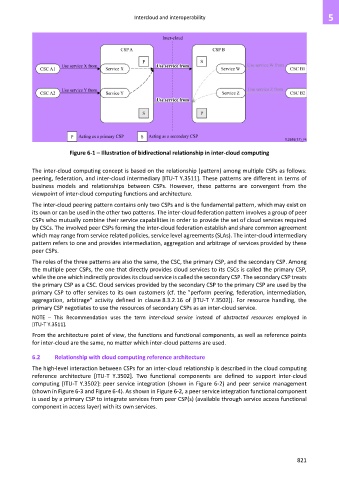Page 829 - Cloud computing: From paradigm to operation
P. 829
Intercloud and interoperability 5
Figure 6-1 – Illustration of bidirectional relationship in inter-cloud computing
The inter-cloud computing concept is based on the relationship (pattern) among multiple CSPs as follows:
peering, federation, and inter-cloud intermediary [ITU-T Y.3511]. These patterns are different in terms of
business models and relationships between CSPs. However, these patterns are convergent from the
viewpoint of inter-cloud computing functions and architecture.
The inter-cloud peering pattern contains only two CSPs and is the fundamental pattern, which may exist on
its own or can be used in the other two patterns. The inter-cloud federation pattern involves a group of peer
CSPs who mutually combine their service capabilities in order to provide the set of cloud services required
by CSCs. The involved peer CSPs forming the inter-cloud federation establish and share common agreement
which may range from service related policies, service level agreements (SLAs). The inter-cloud intermediary
pattern refers to one and provides intermediation, aggregation and arbitrage of services provided by these
peer CSPs.
The roles of the three patterns are also the same, the CSC, the primary CSP, and the secondary CSP. Among
the multiple peer CSPs, the one that directly provides cloud services to its CSCs is called the primary CSP,
while the one which indirectly provides its cloud service is called the secondary CSP. The secondary CSP treats
the primary CSP as a CSC. Cloud services provided by the secondary CSP to the primary CSP are used by the
primary CSP to offer services to its own customers (cf. the "perform peering, federation, intermediation,
aggregation, arbitrage" activity defined in clause 8.3.2.16 of [ITU-T Y.3502]). For resource handling, the
primary CSP negotiates to use the resources of secondary CSPs as an inter-cloud service.
NOTE – This Recommendation uses the term inter-cloud service instead of abstracted resources employed in
[ITU-T Y.3511].
From the architecture point of view, the functions and functional components, as well as reference points
for inter-cloud are the same, no matter which inter-cloud patterns are used.
6.2 Relationship with cloud computing reference architecture
The high-level interaction between CSPs for an inter-cloud relationship is described in the cloud computing
reference architecture [ITU-T Y.3502]. Two functional components are defined to support inter-cloud
computing [ITU-T Y.3502]: peer service integration (shown in Figure 6-2) and peer service management
(shown in Figure 6-3 and Figure 6-4). As shown in Figure 6-2, a peer service integration functional component
is used by a primary CSP to integrate services from peer CSP(s) (available through service access functional
component in access layer) with its own services.
821

